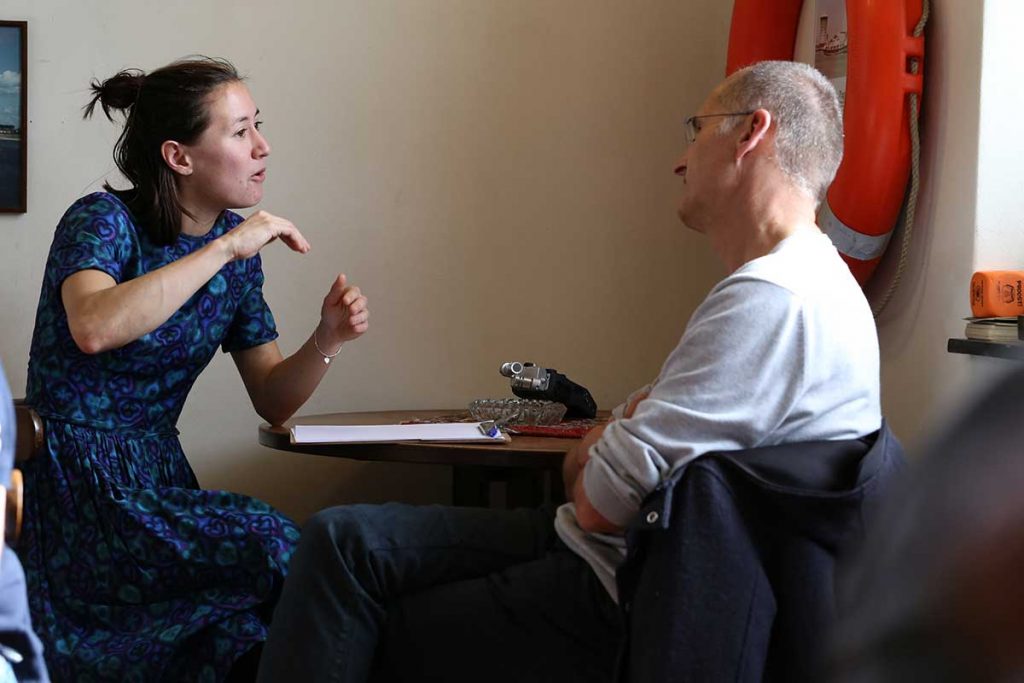The moment I step off the tram in Scheveningen, I am hit by that familiar scent of salt and the touch of the North Sea wind. One by one, we enter the nautical-themed bar De Zeemanshuis. In the center of the room, the pool table is no longer recognisable, its surface covered by a thick layer of table salt. It’s an unlikely gathering: a fisherman, a ship engineer, a poet, a surfer, a diver, a city planner.
Lina Issa, the artist behind The Atlantis Project, asks us what comes to mind when we run our fingers through the salt. Temptation: being thirsty at sea, but unable to drink from the body of water around you… Medicine: for generations used to heal, to cleanse… Pain: the sensation of seawater running through your nose, and stinging your eyes…
As we roll a ball of blue fishing twine towards our fellow participants through the mound of salt, we take turns to answer a question, to reflect on our personal bond with the sea. Many mention the idea of freedom; some attempt to describe the paradoxical feeling of peace that the seaside gives them, even in its roughest and most volatile form. Meanwhile, others have lost loved ones to stormy weather and strong currents, forever tainting their relationships with the sea. Has the sea given you something that you are grateful for? For Issa, the sea provided a lesson in living. As a child, she recalls feeling land-locked in Lebanon. Not being able to move in her own country, she was always able to run into the sea. She remembers experiencing her body as a porous entity as the sea washed over, under and through her. Being porous struck me as a beautiful concept: to recognise our vulnerability, the instability of our own identity, the pointlessness of trying to be retentive. According to Issa, the sea reminded her to let others in, let them become a part of herself and her history. And so begins The Atlantis Project.

We pair up with the person we rolled the twine towards. We are told to focus on one story at a time: one person tells their story whilst the other listens in silence; then the other repeats the story using the pronoun ‘I’, whilst the original storyteller listens in silence (suppressing the urge to interrupt and correct); finally, both discuss the story to provide clarifications and the original storyteller explains how they would have preferred to have their story told. We slowly come to realize, that this storytelling exercise is a lesson in letting go, allowing your story to become someone else’s. Perhaps they will go on to share your story in their own circles; perhaps they won’t. Perhaps in a week, they will forget details from your story, or the passage of time will have colored it with new details. Regardless, they will carry your story with them.
I came to share a story about my decision many years ago to start surfing (riding a board on the face of a moving wave). Perhaps this decision came as an act of teenage rebellion, against my mother who would always shout out to me from the beach, “don’t go in past your knees, or the current will carry you away!” I came to explain how surfing helped me to develop confidence and strength, and overcome certain fears and inhibitions. But I also came to describe the frustrations I encounter near the seaside. When the waves won’t move the way I want them to, when I spend a lot of time planning a trip and the sea doesn’t meet the (unrealistic) expectations I hold her to.
I find myself immensely lucky to be partnered up with a person who was involved with a governmental project to redesign part of the boardwalk and coastline in Scheveningen. This is a project I remember happening; there are developments I remember reading about and changes I remember noticing, back when I used to spend a lot of my time at this coastline. My partner speaks methodically, preferring conclusions over extensive trains of thought. My partners tells me about new methods in coastal protection, explaining how we are learning increasingly to work together with the sea, deepening the entanglement between the artificial and the natural. I find myself listening with eager ears to an account of various marine dynamics, of how coasts change, of how we might take advantage of them responsibly.
The final round of the session: the whole group comes together again around the pool table, and each person shares the story of their partner, narrating it as if it were their own. This is the second time we hear our story told by someone else. It changes again. Perhaps there are omissions of details that we really enjoyed hearing the first time. Perhaps there are embellishments that make us uncomfortable. Perhaps the specifics have already been clouded by time. As the narrators of our stories fail to follow our instructions, we learn how to set our stories free.
It is an unusual experience to listen to your memories being recounted as if they occurred in someone else’s past. In a remarkable exchange of memories, a sturdy sailor describes how he remembers feeling intense shame around his body as a young girl considering joining her friends for a nude swim. And a young poet adds an artful twist to a story she borrows from a fisherman, about his realisation that sealions have been returning to local waters after being a rare sight for many years.
There are many people who spend much of their time in the company of the sea, noticing its subtle changes over time. What pearls of wisdom might they be able to share with us?
Photo (c) Giath Taha
